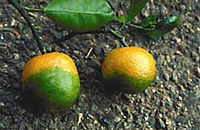
Photo from wikipedia
BACKGROUND Host genetic resistance is a promising strategy for the management of Diaphorina citri Kuwayama (Hemiptera: Psyllidae), and consequently Huanglongbing (HLB). To date, no study has investigated the resistance to… Click to show full abstract
BACKGROUND Host genetic resistance is a promising strategy for the management of Diaphorina citri Kuwayama (Hemiptera: Psyllidae), and consequently Huanglongbing (HLB). To date, no study has investigated the resistance to D. citri in the clonal and vegetatively propagated plants of the Microcitrus, Eremocitrus, and Atalantia genera. This study assesses Near and True Citrus genotype antixenosis and antibiosis against D. citri, with trichome density and volatile emission as possible mechanisms of resistance. RESULTS All genotypes were oviposited by D. citri, however, 8 of 14 genotypes were less oviposited than Citrus × sinensis 'Valencia' (susceptible control). Diaphorina citri nymphs had lower nymphal viability in E. glauca (31%) and M. warburgiana (58%) than that in C. × sinensis (77%). The behavioral assay showed that 30% of D. citri nymphs in the last instars evaded E. glauca shoots, whereas no nymphs evaded C. × sinensis shoots. A higher trichome density was observed in E. glauca shoots compared to the other genotypes. Chemical analysis revealed differences in the volatile profiles of E. glauca and C. × sinensis. CONCLUSION Eremocitrus glauca and M. warburgiana genotypes were more resistant to D. citri than C. × sinensis. Higher trichome density in the shoots may negatively influence the development of D. citri nymphs. E. glauca volatiles may also be involved in their resistance to D. citri. This article is protected by copyright. All rights reserved.
Journal Title: Pest management science
Year Published: 2022
Link to full text (if available)
Share on Social Media: Sign Up to like & get
recommendations!